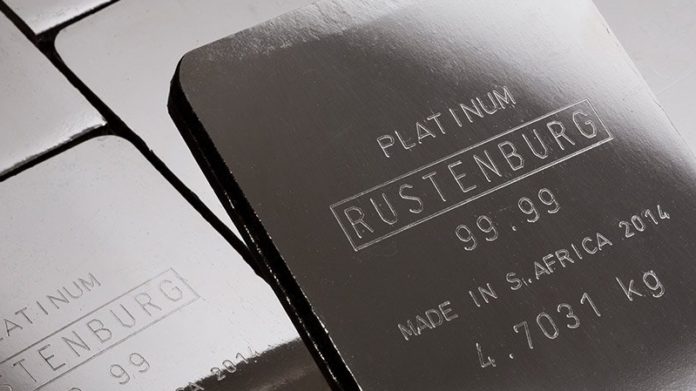
A REBRAND in recent years of platinum companies into platinum group metals (PGMs) producers was to acknowledge the increasing role played by palladium, and more recently rhodium, in the performance of the sector. For instance, the two metals comprised half of Impala Platinum’s (Implats’) revenue in its 2020 financial year even though the company is pre-dominantly a platinum producer by volume.
Yet there’s growing evidence that the much-ignored platinum is finally back on investors’ radar. “A lot of interest that we’ve seen in platinum, whether it’s through futures positioning or whether it’s through EFT (exchange traded funds) holdings has been very much based on the fact platinum continues to be under-valued,” said Suki Cooper, executive director of Precious Metals Research at Standard Chartered Bank in New York at the Joburg Indaba PGM conference earlier this month.
The metal has started to slowly creep up in price. At the time of writing, the dollar platinum price is 14% higher over the last 90 days. It’s still outstripped by palladium pricing, which is nearly a fifth higher over the same time frame, but in the past platinum has languished even as prices for its sister metals surged.
“In the near-term, the recovery certainly does look fragile but longer-term – whether its fuel cell development, whether it’s a fact that demand has perhaps reached the lowest point of the cycle – we are starting to see more optimism,” said Cooper.
So what’s behind a platinum renaissance?
Part of it is the fact investors, having flooded into gold as the realities posed by Covid-19 has been brought to bear on macro-economics, are now looking for new investment options. Platinum and gold used to track one another closely, until gold collapsed in the early 2000s. Analysts think that bond may be re-established in the context of a global recession. “There’s no good reason platinum should be trading at $1,000 per ounce less than gold,” said Trevor Raymond, head of research and investor development at the World Platinum Investment Council (WPIC).
But there’s more to platinum’s resurgence than just the metal itself. There is, in fact, growing evidence that supply of the entire PGM suite is under pressure to meet demand. Whether it’s for rhodium or palladium, nickel or even arcane-sounding metals such as ruthenium, which is also part of the PGM family, future demand may overwhelm the supply response of primary production. In anticipation of this, buyers of the metals, such as automakers that use PGMs in autocatalysts, are setting about substitution of palladium for the less expensive platinum.
Substitution of metals in autocatalysts takes manufacturers time to engineer, but it’s already happening, said Raymond. In the case of rhodium, there would appear to be no ready substitute, hence its astronomical price hikes of the past year: up more than 100% on a rand basis. According to Stephen Forrest, co-founder of industry research house, SFA Oxford – which has been bought by Sibanye-Stillwater, a PGM producer – unfulfilled rhodium demand could even lead to ‘injury’ of the PGM sector.
RETURNS
For PGM shares like Implats, Anglo American Platinum, Northam Platinum and Sibanye-Stillwater, the recent benefits have been enormous. Despite Covid-19 production interruptions, all four have been able to pay some kind of capital return.
But it wasn’t always like this. Less than three years ago, Implats unveiled plans to retrench 12,500 employees from its Rustenburg operations. Its share price sank to about R20/share (compared to R147/share today) which represented an all-time low – low enough for Sibanye-Stillwater to consider a buy-out. In the end, Sibanye-Stillwater opted for the takeover of Lonmin which had retrenched nearly 7,000 employees in its 2016 financial year and was preparing for thousands more.
These recent memories are fresh with the current crop of PGM CEOs which is why few of them are talking aggressive growth plans other than Northam Platinum, which is building up to a million ounces of annual PGM production, a doubling.
The emphasis is, therefore, on increased dividend returns instead of growing supply. Whilst a boon for investors, a dearth of major new production is adding pressure to the supply and demand equation. “We aren’t seeing any significant growth in capital from the mines,” said Simon Kendall, an analyst for Prudential Asset Managers.
In addition to past pains, there’s also future uncertainty. A fair dose of the optimism regarding PGMs is on the transformative effect on demand from the so-called hydrogen economy. As mentioned in a previous Miningmx article hydrogen engines are expected to absorb 400,000 ounces in platinum production by 2030 from demand of less than 50,000 oz today, according to SFA Oxford.
“It seems the sun is shining on the PGM industry now, but it is important to think ten or 15 years out because these assets are 20 to 30 years life assets,” said Mandi Dungwa, a portfolio manager for Kagiso Asset Management.
“You want to ensure that when the sun isn’t shining that your business can survive. So that’s what I’d be looking at, but most importantly for investors it’s that they are very patent to get capital returns out of these investments,” she said.









